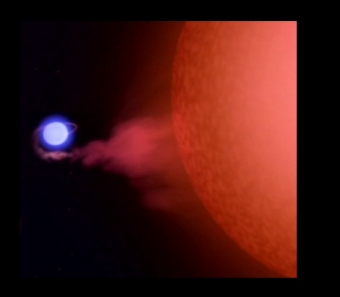
In Star Trek, a plasma streamer is a stream of plasma
between the two stars of a binary system - most commonly, a neutron
star and red giant would be connected by a plasma streamer.
Plasma streams create ionized distortion fields
surrounding them, greatly reducing the efficacy of sensors,
transporters, and even tractor beams. In 2369, the USS Enterprise-D was
sent to the Igo system to investigate the disappearance of the USS
Yosemite, a science vessel sent to remotely observe the stream. (TNG:
"Realm of Fear"). Plasma streamers were also observed in the Kavis
Alpha sector. (TNG: "Evolution") and the Topin system. (TNG:
"Preemptive Strike") .
Descriptions and images of plasma streamers in Star Trek
indicate that these phenomena were actually what are called Cataclysmic
Variables (CVs). Cataclysmic Variable stars are pairs of stars that are
so close together that matter is dragged away from a red dwarf or
evolved star (subgiant) onto an extremely dense white dwarf star.
If the white dwarf has a strong magnetic field the
material falls directly onto the north or south magnetic poles - these
stars are known as polars. However, if the magnetic field is
sufficiently weak, the gas forms an accretion disk around the white
dwarf star before impacting onto the white dwarf.
The visual light we see originates from gas falling
through the disk, and the amount of gas falling through the disk
varies... cataclysmically! Gas begins to builds up in the outer disk,
before falling rapidly through the disk (much like snow does on an
avalanche-prone mountain). As the rate at which gas falls through the
disk varies, so does its visual brightness (optically, the accretion
disk outshines both stars put together). Cataclysmic variables can
brighten by a factor of 100 in just 6 hours, before fading away over a
week. These outbursts (avalanche) cycles can repeat over timescales of
weeks to many years.
Several hundreds of cataclysmic variables are known.
|
